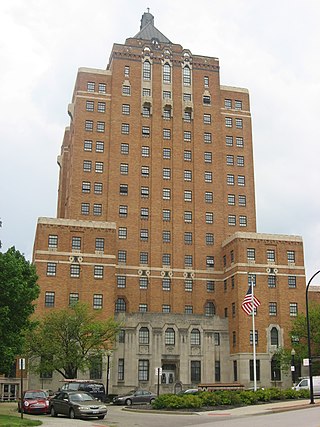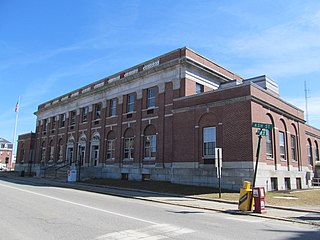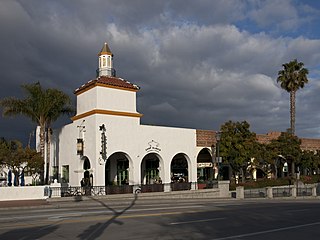
Gilbert Stanley Underwood was an American architect best known for his National Park lodges.

The El Tovar Hotel, also known simply as El Tovar, is a former Harvey House hotel situated directly on the south rim of the Grand Canyon in Grand Canyon National Park, Arizona, United States.

Akron YMCA Building is a registered historic building in Akron, Ohio, listed in the National Register on October 31, 1980. Although the YMCA is still in the building for which it is named, they no longer own the building, and now lease their space from the owner.

The Lewiston Main Post Office of Lewiston, Maine is located at 49 Ash Street in downtown Lewiston. Built in 1933 and enlarged in 1975, it is a fine local example of Colonial Revival architecture. The building was listed on the National Register of Historic Places in 1986 as U.S. Post Office–Lewiston Main.

The former U.S. Post Office in Canandaigua, New York, is located on North Main Street. It is a Classical Revival granite structure built in 1910 and expanded in 1938. It was listed on the National Register of Historic Places both as a contributing property to the Canandaigua Historic District in 1984 and individually in 1988, as part of a Multiple Property Submission of over 200 post offices all over the state.

Corning Armory, since 1977 home to the Corning YMCA, is a historic National Guard armory building located at Corning in Steuben County, New York. It was designed by architect William Haugaard. The historic, main block of the armory is a T-shaped Gothic Revival edifice with terra cotta trim constructed in 1934. The front portion, the former administration building, is a two-story, seven-bay structure flanked by two one-and-a-half-story wings. The rear section is the former drill shed.

The Architecture of Buffalo, New York, particularly the buildings constructed between the American Civil War and the Great Depression, is said to have created a new, distinctly American form of architecture and to have influenced design throughout the world.

The El Paso and Southwestern Railroad YMCA, also known as the Douglas YMCA, is a large brick building in Douglas, Arizona. It was listed on the National Register of Historic Places in 1984.

The Lee County Courthouse, also known as the South Lee County Courthouse and the U.S. Post Office and Courthouse, is a historic building located in Keokuk, Iowa, United States.

The Keokuk Young Women's Christian Association Building is a historic building located in Keokuk, Iowa, United States. It was listed on the National Register of Historic Places in 2004.

The Andalucia Building was built in 1911. It was listed on the National Register of Historic Places in 1999. The building is located on State Street, in the southeastern part of the historical center of Santa Barbara, California, immediately next to the Highway 101. The building is one of the few examples of Moorish architecture in Santa Barbara.

The Somerset County Courthouse is a historic county government building on Court Street in downtown Skowhegan, Maine, the county seat of Somerset County. The brick building was designed by local architect Charles F. Douglas and built in 1873, with an addition by John Calvin Stevens in 1904, and a second addition added in 1938. The building continues to serve county functions; it was listed on the National Register of Historic Places in 1984.

Monte Vista Elementary School is a public elementary school in the Nob Hill neighborhood of Albuquerque, New Mexico, whose campus is listed in the New Mexico State Register of Cultural Properties and the National Register of Historic Places. It is notable as one of the city's best examples of Mediterranean Revival architecture and as the historical focal point of the surrounding neighborhood. It is a part of Albuquerque Public Schools.

Bennington station is a historic former railroad depot at 150 Depot Street in downtown Bennington, Vermont. Built in 1897-98 by the Bennington and Rutland Railroad, it is the only Richardsonian Romanesque railroad station in the state of Vermont. It was listed on the National Register of Historic Places in 1988 as Bennington Railroad Station, and since then housed a restaurant, which closed in 2018. It now is an office space for MSK Engineering and Design and Goldstone Architecture.

The Toledo and Ohio Central Railroad Station, today named Station 67, is a union meeting space and event hall located in Franklinton, near Downtown Columbus, Ohio. Built by the Toledo and Ohio Central Railroad from 1895 to 1896, it served as a passenger station until 1930. It served as an office and shelter for Volunteers of America from 1931 to 2003, and has been the headquarters of International Association of Fire Fighters Local 67, a firefighters' union, since 2007. The building was placed on the National Register of Historic Places in 1973. During its history, the building has experienced fires and floods, though its relatively few owners have each made repairs and renovations to preserve the building's integrity. The building is the last remaining train station in Columbus.

The YMCA Building is a historic building located in Waterloo, Iowa, United States. The local YMCA was established in 1868, three months after the city was incorporated. Its first permanent building was built at this location in 1893. As membership expanded they eventually out grew the building, and it was torn down in 1930. The present building was designed by local architect Mortimer Cleveland and his associate D.B. Toenjes. The general contractor was H.A. Maine Construction. The three-story brick structure features decorative elements from the Art Deco mode. The first level has housed commercial firms in the storefronts. An addition was built onto the west side of the building in 1959 to house adult activities. The local YMCA built a new facility and moved from here in 1982. The following year the building was listed on the National Register of Historic Places. It has been converted into an office building.

The Muskegon YMCA Building is a YMCA building located at 297 West Clay Avenue in Muskegon, Michigan. It was listed on the National Register of Historic Places in 1982. It has been renovated, and currently houses 297 Clay Condominiums.

The Quincy Hotel is a historic commercial building at 57 Depot Street in the Enosburg Falls village of Enosburgh, Vermont. Built about 1876 in the Second Empire style, it was restyled after a fire in the early 20th century to its present Colonial Revival appearance to a design by Vermont architect Lewis Newton. It was listed on the National Register of Historic Places in 2019 for its architectural significance.

The Douglas-Sixth Street Historic District, in Las Vegas, New Mexico, is a historic district which was listed on the National Register of Historic Places in 1983. The listing included 18 contributing buildings, a contributing site, and two contributing objects.






















